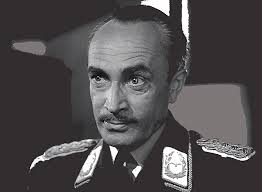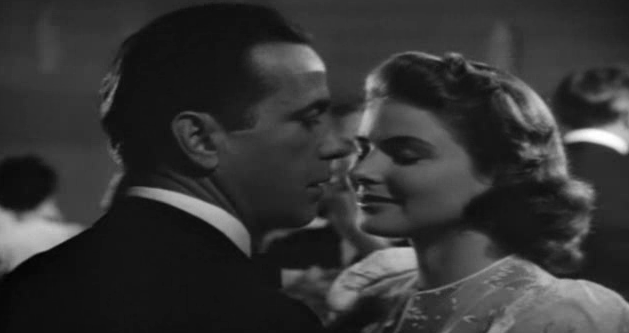Cast – Key Characters
Humphrey Bogart
Character – Rick

Before Casablanca, Bogart was already a veteran star, but hardly the top actor in the industry. He became a star when playing the lead role in The Maltese Falcon (1941). Before he was a character actor who was tough without a gun, he mainly was in gangster movies or crime and detective genre. He was not none as being a romantic lead in a movie previously. Bogart was unhappy when it came to scripts as they where given normally on the day when they where filming. He was only on the contract for Warner Brothers, and he was normally known for smaller parts until he was the lead role in Casablanca. His traits where cynical and selfish.
Ingrid Bergman
Character – Ilsa Lund

Was casted when the writers though about having a lead female character who was foreign, as they wanted to showcase many people all over Europe wanted to escape Europe and go to America. She remade a film in America from a film in Swedish. She is fresh-faced foreign actress. Bergman’s noteable performances in the 1940’s include the whom the bells trolls, which earned nominations for the best actress.
Paul Henreid
Character – Victor Laszlo

Paul was an Austrian – American actor, director. He appeared in films such as Goodbye Mr, Chips and Night train to Munich before starring in Casablanca. He played many roles during the second worlds War, and was acting in film with romance.
Claude Rains
Character – Captain Louis Renault

Claude Rains was a British and American actor. He starred in movies such as The invisible man, Now, Voyager, the wolf man and many more before starring in Casablanca.
Conrad Veidt
Character – major Heinrich Strasser

Conrad was German but naturalised British actor. He was in movies such as The Man Who Laughs, All through the night, The spy in Black before he starred in Casablanca. He died in 1943 and the role of Major Strasser was his last role.
Sydney Greenstreet
Character – Signor Ferrari

Greenstreet was a British and American actor. While he did not begin his career in films until the age of 61, he had of significant motion pictures in a Hollywood career lasting through the 1940s. Movies he was in – across the pacific, and the Maltese falcon.
Peter Lorre
Character – Ugarte

He is Slovakian, but worked with German producers and films. He was known for his timidly devious characters, his appearance and accented voice he was frequently typecast as a sinister foreign. Movies he was in before Casablanca – The Maltese Falcon, The man who knew too much.
S.Z Sakall
Character – Carl

He was Hungarian – American stage and film character actor. He appeared in many prominent movies, including Casablanca, Christmas in Connecticut, In the good old summertime
Madeleine Lebeau
Character – Yvonne

She was a French film actress who also appeared in American Films. Casablanca was the her first movie and after it she played many movies such as, Parisians, The country I come from and many other film both in French and in English.
Dooley Wilson
Character – Sam

He was an American actor, singer and musician. He played in movies such as Cairo, My favourite Blonde, Take a letter, Darling before he starred in Casablanca as the pianists.
Director of Film

Michael Curtiz
He was a Hungarian Refugees. Has knowledge of trying to leave Europe. He casted refugees to be the extras. Most of them where immigrants. Curtiz directed 173 movies. He broke away from the normal Hollywood style of camera movements like using the dolly shots and the movement of the actors which was seen as the dancing with the camera. Script came after Pearl Harbour (it is what brought America into the war). There was 34 different nationalities behind and in front of the camera
- Mise En Scene
The set design of the film was supposed to look like they where built, however contain special and suitable props for example shutters, lamps exotic plants which was to create some sort of reality and verisimilitude of items in Casablanca. The set design was supposed to feel like a magical place unlike the real country itself. The costumes where important as it gave extra gleam towards the film. Many of the key characters had there own colour pallet for example, Ilsa had very light colour which connoted innocence and youth.

- Sound
Music played an important role in the movie as they had important character information for example when there was mention of Germans they would play a more ominous sound This would be an example of non diegetic sound as only the audience can hear it. The sound also provided key themes for the Film to make a point. And they sound acted as a classical motif. The frequent use of the song ” as time goes by” showed the audience the way the film connoted idea and genre for example it being romantic showing the song mean a lot of precious times for Rick and Ilsa.
- Editing
The editing of the film was very fast pace with many shot reverse shots being used. Although the film was an 1 and 20 minutes it felt less more like just 20 minutes due to the fast pace editing. The editing also showed key character information and each of the characters personalities. Many close up used a lot to convey emotions and the close up shot where normally held for longer. The editing of the scene getting darker created the feeling of when characters where in love and held intimacy with each other. The film adheres to the rule of classical Hollywood continuity editing. The editing appears seamless and invisible throughout.

- Aesthetic
Although the film is not real, many part of the film could be real aspects to some people’s life’s. It has become the most recognizable ” screen memory ” of the escape and exile routes of World War II. The aesthetics depict a sense of romantic longing- smoky bars, exotic location, the foggy runway and wartime costumes all contribute to the film’s classical look. The film combines the aesthetics of film noir, expressionism, melodrama and documentary. Warner’s tight budget policy was reflected in the aesthetics of their films – low-key lighting and fog were often used to disguise cheap sets, as evident in the final scene in the aircraft hangar.
– Themes and issues :
Isolationism – what was America’s view on world war ll ?
88% of Americans opposed the idea of declaring war against the axis power in Europe. As late of June 35% of Americans believed their government should risk war to help the British. Rick represents US foreign policy, from isolationist to
intervention. Rick displays neutrality and portrays isolation tendencies. After pearl harbour the US had finally break their neutrality and join WWll. Later Rick shoots a German in order to help Ilsa. At the start 96 % of Americans wanted to stay out of the war. Rick turn from being a cynical guy, who is tough, and horrible to women then he becomes a sentimental and loveable guys who is willing to help a lot of people, and becomes patriotic for his country. - The producers of the film (Hal B. Wallis) Casablanca oversea the whole film production they put the team together by creating the scripts, coordinate scenes etc. The film starts to promote propaganda.
- Representation Featured
– Women = the main female character Ilsa is incapable of making her own decisions. Ilsa is shown to be torn between two male characters in the film showing that she cannot make a choice and it is Rick who makes the choices of duty over love The women are either victims or trophies to be competed for between men. The camera portrays these women literally in a different light than it does the men: they are more brightly lit, without shadows, and very often in soft focus. Both in her entrances into scenes and in her conversations with other characters, Ilsa maintains the attention of the camera; in several instances the lens remains fixated upon her even when she is not speaking.
– Men = The film occurs in very male dominated world. The plot and the historic timeline that it follows reflects stereotypically masculine concerns: war, duty to country, and freedom. Rick turn from being a cynical guy, who is tough, and horrible to women then he becomes a sentimental and loveable guys who is willing to help a lot of people, and becomes patriotic for his country.
– people of colour- there is only one person in the film who is a person with colour, which is Sam who is the pianist. Sam follows alongside Rick. Sam came from Paris then came to Casablanca when Rick asked him to continue playing the piano from rick at his café/bar.
– Overall there are many different cultures represented. Furthermore there where a lot of actors playing German roles. For example there is a German couple represented as being comedic and lively while they are talking about leaving the country to go to America. There was also Refugees, from all over Europe, who where casted by the director to play small parts and extras in the film.
Historical and Political context in Casablanca
Casablanca takes place on the four days leading up to the Japanese attack on the US military base at Pearl Harbour on 7th December 1941. The event led directly to USA entry into WW2. Rick represents US foreign policy, from isolationist to
intervention.
Allies – Britain, USA and USSR
Axis – Germany, Italy and Japan
France – France begins as Allies, but soon into the war they where invaded and became occupied by Germany. There was some soldiers decided to continue to fight. Vichy France was a territory and had tis own government but was like a puppet to the Germans. Morocco was part of the French (Vichy) territory.
The World War ll started in 1939 America started the war in 1941 due to the Pearl Harbour bombing.
- Operation Torch
“it captured the zeitgeist”
– Zeitgeist = spirit or mood of a particular period of history as shown by the ideas and beliefs of the time.
– Operation Torch (8th November 1942) was an Allied invasion of French North Africa during the second World War. Torch was a compromise operation that met the British objective of securing victory in North Africa while allowing American armed forces the opportunity to begin their fight against Nazi Germany and Fascist Italy on a limited scale. - Opening world Premier of Casablanca – It had its world premiere on November 26, 1942, in New York City and was released nationally in the United States on January 23, 1943. The cinema showed movie reels that communicated the news to the public. Otherwise you would get the news from the radio or newspaper.
- Casablanca Conference
– The Casablanca Conference was a meeting between U.S. President Franklin D. Roosevelt and British Prime Minister Winston Churchill in the city of Casablanca, Morocco that took place from January 14–24, 1943. During the first month of 1943, President Franklin D. Roosevelt and British prime minister Winston S. Churchill met at the Anfa Hotel in Casablanca in French Morocco for a ten day conference to plan the next stages of the war against the Axis.
serendipity – the luck of something or chance.
Good research Sophia – well illustrated